On Monday, Milton Keynes marks the 50th anniversary of its designation as a new town. To celebrate, we’ve selected 50 reasons to love Buckinghamshire’s leading collection of roundabouts. I know what you’re thinking: what, only 50?
1. The grid
The visionary city is based on a grid network. All main roads are designated H or V depending on whether they run horizontally or vertically. In the future, it is hoped, there will also be D and T boulevards, where D stands for diagonal roadways, and T for time machines.
2. WD-40
The world’s favourite retail mechanical lubricant is made in Milton Keynes. Only six people know the recipe, so imagine how much more squeaking there would be in the world if they died in a freak accident or were bumped off by business rivals.
3. Concrete cows
Among the city’s 220 works of public art is this 1978 sculpture by Canadian artist Liz Leyh consisting of three cows and three calves, roughly half life-size and so, you’d think, confusing to wandering livestock. Shortly after former culture minister Kim Howells raged against modern art’s “cold, mechanical, conceptual bullshit” in 2002, concrete cow pats appeared beneath the sculpture.
4. Parking
There are more than 20,000 parking spaces in central Milton Keynes, happily not all of them currently filled by cars.
5. Convenience
Some 7.5 million people live within a one-hour drive of Milton Keynes; it’s unfair to suggest that many of them would rather live two hours away.

6. Proximity to other places
Milton Keynes was originally envisaged as a London overspill zone, following the recommendations of governmental studies in 1964 and 1965 to build “a new city” incorporating existing towns such as Bletchley, Stony Stratford and Wolverton.
It has become so much more, while not quite overcoming native sniffiness. As writer Neil Gaiman once noted: “Milton Keynes is a new city approximately halfway between London and Birmingham. It was built to be modern, efficient, healthy and, all in all, a pleasant place to live. Many Britons find this amusing.”
7. Planning
The ideas of Californian urban theorist Melvin Webber, who believed that the traditional concentric city would be superseded by “community without propinquity”, proved influential among Milton Keynes planners. It was envisaged as a low-density, low-rise city of light industry and convenience. Hence the city’s distinctive 1km-sized “grid squares”, or suburbs, where “workers, managers, vicars and doctors” would mingle in shops, schools and AFUs (advanced factory units).
8. Parks
Architect Richard Llewelyn-Davies’s masterplan left 40% green space in the city, and two valleys as linear parks with lakes to hold floodwater. Today two-fifths of Milton Keynes is open space. If London had been built according to such principles, it would be the size of East Anglia.
9. Roundabouts
Milton Keynes has about 130 roundabouts. It is hard to be more precise about their number since it is growing all the time. Like concrete cow pats, but bigger, they appear mysteriously overnight.
10. Greenery
Sometimes you don’t think you’re in a city. Houses and industrial estates are often hidden behind grassy banks and thickets of willow, pine and dogwood. If Italo Calvino had visited he’d have had to have added a Milton Keynes chapter to his Invisible Cities.
11. It gets bullied
The city has its detractors. In the 1970s, fogeyish Private Eye founder Christopher Booker called it “the utterly depersonalised nightmare which haunted Aldous Huxley just 40 short years”, while more recently architectural critic Owen Hatherley damned the city for its “bland, kitsch, Thatcherite reality”, adding: “Today, Milton Keynes is still the non-place it was planned to be.”
12. A warm welcome
Milton Keynes was premised on the cultivation of community spirit and charitable sentiment. Dr Phyllis Starkey, MP for Milton Keynes South West from 1997-2010, wrote: “In the early days families arriving received a welcome pack with information on local facilities, and one house was designated a temporary community centre to create a focus for the new neighbourhood. Just a few more reasons why Milton Keynes is a model worth following.”
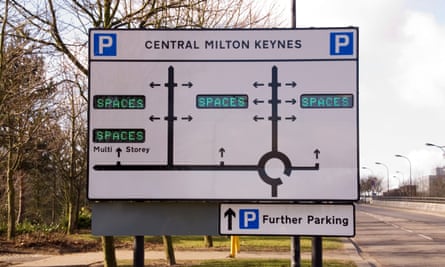
13. It’s a mystic portal to a higher realm
Midsummer Boulevard is so called because the sun rises at its east end on the summer solstice. This was no accident; in the trippy early 70s, architects consulted Greenwich observatory to obtain the exact angle required at their latitude in Buckinghamshire and then persuaded engineers to shift Milton Keynes’ grid of roads a few degrees. One solstice, the architects lit an all-night bonfire – and some marijuana – and played Pink Floyd on the green fields they would soon pave.
14. More shoreline than the entire island of Jersey
The 119 square miles city has 15 lakes and 11 miles of canals. (Birmingham, of course, boasts more miles of canals than Venice and more trees than Paris, so take it with a grain of salt.)
15. Progressivism
Milton Keynes is philosophically premised on something unusual in nostalgia-hobbled, class-stratified, can’t-do Britain. Pete Marland, leader of Milton Keynes council says: “People came to MK to be part of something new where everyone could shape their place called home. This created a community keen to progress and move forward.”
16. Driverless cars
Trials with Britain’s first driverless car through pedestrianised parts of Milton Keynes were a success last year. The two-seater LUTZ Pathfinder reached speeds of 15mph, which is faster than the average vehicle speed in London, where gridlocked motorists have recently created their own driverless cars by chucking the keys through the window and wandering off. By 2018 there is expected to be a fleet of 40 pods of driverless cars changing how people travel around Milton Keynes.
17. Electric cars
It is also a Go Ultra Low city with initiatives including a network of electric car charge points, and electric bus fleets. Last year Milton Keynes received £9m to encourage the use of plug-in cars to reduce emissions.
18. Ratio of shrubs to humans
Milton Keynes has more than 22 million trees and shrubs, around 100 for every resident.
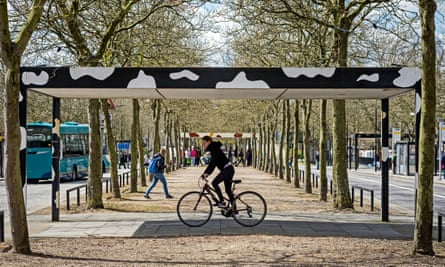
19. Really nice paths
It also has more than 180 miles of bridleways, footpaths and cycle tracks.
20. State funding
Milton Keynes started off as a state-funded city and today could serve as a model for how urban planning can confound austerity today. In the economically bleak 1970s, the government loaned Milton Keynes Development Corporation money, and “as soon as this land was developed, it became far more valuable: this uplift paid for MK’s infrastructure,” as Patrick Barkham pointed out in the Guardian.
21. It had Britain’s first multiplex
It also claims the UK’s first peace pagoda, its first purpose-built ecumenical church and its first kerbside household recycling.
22. Eco-houses
In 2008, eco-houses in Oxley Woods won architecture’s prestigious Manser award. These pre-fabricated properties, built in 2007 for just £60,000 each, could be knocked up in 24 hours and were hailed at the time by deputy prime minister John Prescott as a means of overcoming Britain’s housing shortage. Later reports highlighted leaking windows and mould, but let’s not spoil the story.
23. You can ski
At Snozone in the Xscape leisure complex are two 220ft-high real snow slopes, topped up each day with fresh snow. Excellent – even if Snozone should have a “w” and Xscape is an intolerable neologism.
24. Torvill and Dean
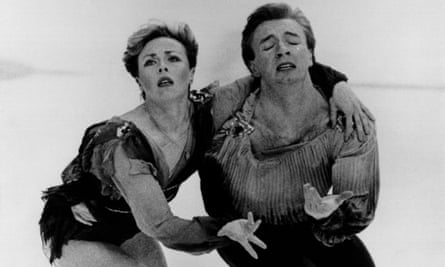
If you aren’t humming Ravel’s Bolero yet, you will after learning that the city’s Planet Ice rink was used for practice by the 1984 Olympic gold medal-winning ice dance duo.
25. The 40ft long, 15ft tall Tyrannosaurus rex at Gulliver’s Dinosaur Park
26. Its name
Unfortunately, it’s not true that Milton Keynes was named after two great, if ideologically opposed, economists. Nor is it true that the other name considered in 1967 for the city was John Maynard Friedman. However, the village of Milton Keynes – from which the 50-year-old city gets its name – was once Middletone, and owned by a Norman family named de Cahaines, from whom Keynes may have descended.
27. The first public infinity edge pool
Sadly, this was demolished in 2010 just before English Heritage could list it.
28. MK Dons
The football club’s home is a 30,000-capacity all seater stadium in the city. Originally called Wimbledon FC, it controversially relocated from south London in 2003. Confusingly, today it shares its nickname with a new club – AFC Wimbledon, also known as the “Dons”. Fans of the former refer to themselves as “Wombles”, a moniker formerly applied to devotees of Wimbledon FC. These facts poignantly highlight the complex nature of cultural deracination and sporting commodification so prevalent in the modern game.
29. Britain’s smallest canal lock
Fenny Stratford Lock has a drop of about 1ft, which makes its existence appealingly daft.
30. Black Horse
Elisabeth Frink’s delightful 1978 sculpture Black Horse was commissioned by Milton Keynes Development Corporation, sponsored by Lloyds Bank and positioned outside one of its branches, long before we, the British taxpayer, had to bail out the boneheads who ran the bank into the ground.
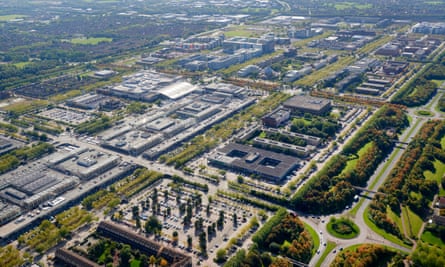
31. It is bidding to become European Capital of Culture in 2023
Perhaps the bidders recalled Arnold Wesker’s play, in which someone defends the town thus: “But after all Milton Keynes is the home of the Open University and it’s not all that dead here and there’s this gallery … ”
32. The Open University
Since 1971, more than 1,600,000 people have studied with the Open University, whose 48-hectare campus headquarters is in Milton Keynes. It is the fruit of Labour’s general-election manifesto commitment to establish what was variously called a University without Walls or a University of the Air; ie, a public distance-learning and research university that would give opportunities to many who would otherwise not be able to enjoy tertiary education, which is precisely what it has done, not to mention earning itself a stellar academic reputation.
33. Its F1 team
The Milton Keynes-based Red Bull Racing team won four back-to-back constructors’ and drivers’ championships from 2010-2013.
34. The Cowper & Newton Museum
This delightful museum in Olney was once the home of poet William Cowper, who wrote the immortal lines: “Variety’s the very spice of life / That gives it all its flavour.” If Cowper were was writing today he would probably substitute “Milton Keynes” for “variety”.
35. A 12ft wind tunnel for indoor skydivers
Cowper also wrote: “God moves in a mysterious way / His wonders to perform. He plants his footsteps in the sea, and rides upon the storm.” You can simulate that divine experience by climbing inside the iFly Indoor Skydiving tunnel.
36. Amazing Grace
All together now: “Amazing Grace, how sweet the sound / That saved a wretch like me. / I once was lost but now I’m found. Was blind but now I see.” These words were written by former slave trader turned abolitionist campaigner, the Rev John Newton (1725-1807), who lived in Olney.

37. It is Britain’s fastest growing city
In 2013, Milton Keynes had around 255,700 residents – expected to rise to almost 300,000 people by 2026 and 325,000 by 2037. Thirteen people move there each day. How many leave each day, you ask? Apologies, I don’t have figures to hand.
38. Really
Like Cambridge, Oxford, Swindon and Norwich, Milton Keynes is a member of the Fast Growth Cities group. “Their ability to attract these knowledge-based businesses puts them in a strong position to continue to grow in the future,” wrote Centre for Cities researcher Marie Williams.
39. The internet of things
Milton Keynes is at the leading edge of digital research. In a joint project with Cambridge-based startup Neul, BT built 15 base stations across the city in 2014 connected to the internet with the aim of picking up signals from sensors in thousands of objects: bins that can send out alerts when they’re overflowing, soap dispensers that get clamorous when they’re empty, parking spaces that can let you know they’re free.
40. It wants to be Britain’s Silicon Valley
In November the National Infrastructure Commission’s interim report into the Cambridge – Milton Keynes – Oxford corridor stated Milton Keynes could become a global showcase for science, technology and innovation. If you look at a relief map, though, you won’t see a valley – silicon or otherwise – so much as a slight depression. To be fair, Britain’s Silicon Depression doesn’t really have a ring to it.
41. It has more show homes than any other city in Britain
This is the eighth entry on the tourism board’s list entitled 101 Facts About Milton Keynes. (“Think you know Milton Keynes? Well...”)
42. The National Bowl
This former clay pit was landscaped to form an amphitheatre in 1979 that, in its pomp, would attract as many as 65,000 alfresco punters per night to recline on grass overlaying a subsoil excavated by the many new developments. Bowie, Michael Jackson and Queen were among the stars who played there, and I recall watching Motorhead’s Lemmy gamely bawling Ace of Spades through Buckinghamshire mizzle. Sadly, its glory days seem to be over: this year’s Electric Daisy Festival of trance and electronica has been cancelled.
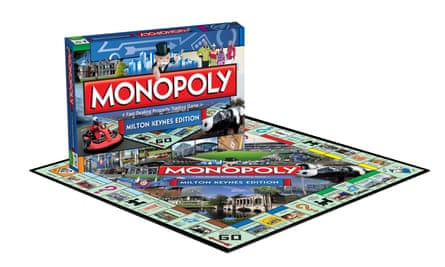
43. Without Milton Keynes there would have been no OK Computer
In 1970, lovely jazzbo couple Cleo Laine and Johnny Dankworth set up The Stables, a thriving music venue, in the grounds of their home in the village of Wavendon near Milton Keynes. Amy Winehouse, Dave Brubeck, Dan Simpson, Joan Armatrading, Courtney Pine and Janis Ian are among the artists who’ve performed there. The couple also established the National Youth Music Camps at the Stables, one of whose alumni is Radiohead’s Thom Yorke. It’s an exaggeration to say without Milton Keynes there would have been no OK Computer, but let’s say it anyway.
44. It defeated the Nazis
Just as some find it hard to suspend their disbelief long enough to accept that Kate Winslet and Benedict Cumberbatch were our last line of geek defence against Nazi coding whizzes, so others find it impossible to believe that Milton Keynes was at the epicentre of Britain’s intelligence community. But it is nonetheless true. The world’s first semi-programmable electronic computer, Colossus, was installed at Bletchley Park. The Enigma code was cracked there too during the second world war, an intellectual feat considered to have shortened the war by two years.
45. The Milton Keynes City Orchestra
This orchestra has performed all over the world, and in August will once more delight us at the Proms in Campbell Park, to which the most sensible will arrive by National Cycle Routes six and 51.
46. Rachel Barnett
The city’s writer in residence is even now penning short stories about public art in central Milton Keynes to celebrate the 50th anniversary. Fingers crossed they will include The Riddle of the Concrete Cow Pats and the Lloyds Bank Black Horse Bailout Mystery.
47. It has its own Monopoly edition
The special set features its four stations (Milton Keynes, Fenny Stratford, Bletchley and Wolverton). Instead of Old Kent Road it has Concrete Cows and instead of Mayfair it has Bletchley Park.
48. It’s a model for new cities worldwide
The International New Town Conference, to be held in June in Milton Keynes, features seminars from city planners. Developments in India and China have been based on the MK formula. According to the blurb: “A city that started as the dream of politicians and planners in the late 1960s is now home to almost 270,000 residents and 11,000 businesses, and is a cultural artefact in its own right.”
49. Mall poetry
In 2014, a robot called Skryf etched lines from a poem called Equinox by Jackie Kay on the floor of the Centre MK shopping centre in a project for the Milton Keynes International Festival. It was a poem that Kay, who had been given up for adoption as a baby, was inspired to write after meeting her birth mother as an adult outside Boots in the shopping centre – and, later, losing her to dementia. The resulting artwork was beautiful and rather disturbing.
50. It’s a network of paradoxes
Car-fixated yet green, invisible yet present, philistine yet cultured, laughable yet earnest, English yet not. As Jackie Kay said, the city’s oxymoronic character is appealing: “The squares and the circles, the sacred and secular, the built landscape and park lands, the ecological and the creative. It’s a town built on a green ethos – they had a policy that if there was a well-established tree standing in the way, they would build the roads around it – and yet its public image is a bit of a joke. I like that.” Me too.
Follow Guardian Cities on Twitter and Facebook to join the discussion, and explore our archive here
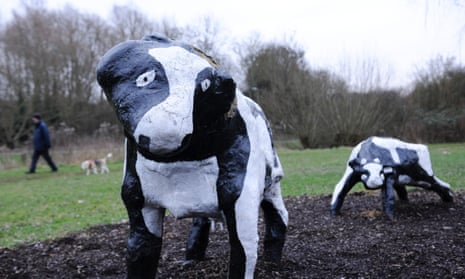
Comments (…)
Sign in or create your Guardian account to join the discussion